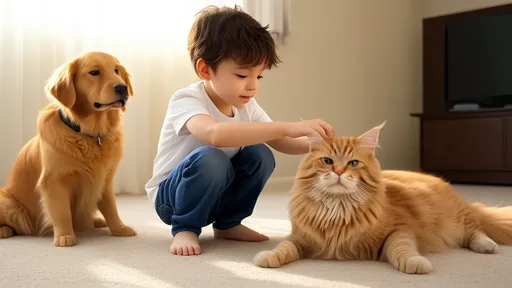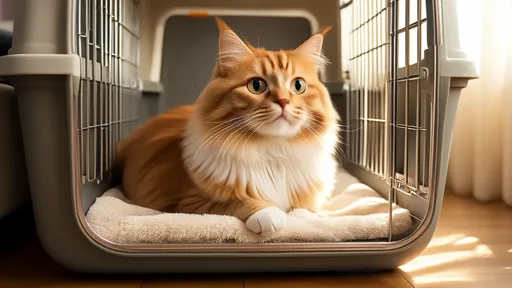Bringing a cat into a household with children or other pets can be a joyful yet challenging experience. Cats, known for their independent and sometimes aloof nature, require careful introduction and ongoing management to ensure a peaceful coexistence. Whether you have toddlers, dogs, or other small animals, understanding feline behavior and creating a safe environment is key to fostering harmony.
The first step in ensuring a smooth transition is recognizing that cats are creatures of habit. Sudden changes in their environment can lead to stress, which may manifest as hiding, aggression, or even health issues. When introducing a cat to children, it’s important to teach the little ones how to interact gently. Cats often interpret loud noises and sudden movements as threats, so encouraging calm behavior around the new pet is crucial. Similarly, if there are other pets in the house, such as dogs, a gradual introduction process is necessary to prevent territorial disputes.
One common mistake many families make is assuming that cats and dogs will naturally get along. While some may become fast friends, others may need weeks or even months to adjust. Dogs, especially those with high prey drives, may see a cat as something to chase. To mitigate this, initial interactions should be supervised, with the dog on a leash and the cat free to retreat if needed. Over time, as both animals become accustomed to each other’s presence, they may develop a mutual tolerance—or even affection.
For households with smaller pets like birds or rodents, extra precautions are necessary. Cats are natural hunters, and their instincts can kick in even if they’ve never been outdoors. Keeping smaller pets in secure cages or separate rooms when unsupervised is the safest approach. Even if your cat seems disinterested, it’s better to err on the side of caution to prevent any tragic accidents.
Another aspect to consider is the cat’s personal space. Cats value their alone time and often seek out quiet, elevated spots where they can observe their surroundings without feeling threatened. Providing cat trees, shelves, or even a dedicated room where the cat can retreat ensures they feel secure. Children should be taught that when the cat is in its safe space, it should not be disturbed. This not only reduces stress for the cat but also minimizes the risk of scratches or bites that can occur when a feline feels cornered.
Feeding time is another potential point of conflict, especially in multi-pet households. Cats and dogs have different dietary needs, and some dogs may be tempted to steal the cat’s food. To avoid this, feed them in separate areas or at different times. Some families find it helpful to place the cat’s food bowl on a high surface that the dog can’t reach. Water bowls, however, can usually be shared as long as they are kept clean and refreshed regularly.
Playtime is an area where supervision is essential. While play between children and cats can be beneficial for bonding, it’s important to ensure that the play remains gentle. Avoid using hands or feet as toys, as this can encourage biting and scratching. Instead, provide wand toys, balls, or other interactive toys that keep a safe distance between small hands and sharp claws. Similarly, when dogs and cats play together, watch for signs of overexcitement. What starts as fun can quickly escalate if one pet becomes too rough.
Grooming and health care are also critical components of a harmonious household. Regular vet check-ups for all pets help prevent the spread of parasites and illnesses. Flea treatments, for example, should be administered to both cats and dogs if one has an infestation. Additionally, keeping the cat’s litter box clean and in a location inaccessible to dogs is important—some dogs have a disturbing habit of raiding the litter box, which can lead to health issues for both animals.
Finally, patience is perhaps the most important virtue when integrating a cat into a home with children or other pets. There will be moments of friction, and progress may seem slow. But with consistent effort, clear boundaries, and plenty of love, most cats can adapt beautifully to their new families. Over time, the once-wary kitten may curl up next to the family dog, or the aloof older cat may become a child’s devoted companion. The key is to respect each pet’s individuality and allow relationships to develop naturally.
In the end, the rewards of a harmonious multi-pet household are well worth the effort. Watching a child gently stroke a purring cat or seeing a dog and cat nap together in the sun are moments that make the challenges fade away. By prioritizing safety, understanding, and patience, families can create an environment where everyone—furry or otherwise—feels at home.

By /Jun 28, 2025

By /Jun 28, 2025

By /Jun 28, 2025

By /Jun 28, 2025

By /Jun 12, 2025

By /Jun 12, 2025

By /Jun 12, 2025

By /Jun 12, 2025

By /Jun 12, 2025

By /Jun 12, 2025

By /Jun 12, 2025

By /Jun 12, 2025

By /Jun 12, 2025

By /Jun 12, 2025

By /Jun 12, 2025

By /Jun 12, 2025

By /Jun 12, 2025